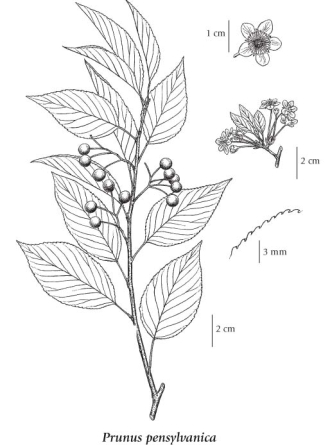Prunus pensylvanica L. f.
pin cherry (bird cherry)
Rosaceae (Rose family)
Introduction to Vascular Plants
pin cherry (bird cherry)
Rosaceae (Rose family)
Introduction to Vascular Plants
Introduction
This is a small deciduous species of cherry tree that is native to BC.
|
Species Information
General:
Shrub to small tree, 1-5 (10) m tall, sometimes thicket-forming; bark reddish-brown, peeling in horizontal strips, with prominent lenticels.
Leaves:
Alternate, deciduous, lanceolate to narrowly egg-shaped or elliptic, 3-8 (10) cm long, finely saw-toothed, gradually tapering to long point at tip, rounded to pointed at the base, smooth; leaf stalks (5) 10-20 mm long, with 1 or 2 small glands near the top.
Flowers:
Inflorescences short, half-rounded to nearly flat-topped, umbel-like clusters, at the ends of short spur-shoots, of 4 to 12 stalked flowers; corollas white, saucer-shaped, the petals 5, egg-shaped, about 6 mm long, usually long-hairy on the back near the base; calyces smooth, 5-lobed, the lance-oblong lobes 2-3 mm long; ovaries superior; stamens about 30.
Fruits:
Fleshy, large-stoned drupes (cherries), ellipsoid to globe-shaped, 4-8 mm long, bright red; seeds 1.
Illustration

If more than one illustration is available for a species (e.g., separate illustrations were provided for two subspecies) then links to the separate images will be provided below. Note that individual subspecies or varietal illustrations are not always available.
Illustration Source: The Illustrated Flora of British Columbia
USDA Species Characteristics
Flower Colour:
White
Blooming Period:
Mid Spring
Fruit/Seed characteristics:
Colour: Red
Present over the Summer
Source: The USDA
Ecology
Ecological Framework for Prunus pensylvanica
The table below shows the species-specific information calculated from
original data (BEC database) provided by the BC Ministry of Forests and Range.
(Updated August, 2013)
The table below shows the species-specific information calculated from
original data (BEC database) provided by the BC Ministry of Forests and Range.
(Updated August, 2013)
| Site Information |
Value / Class |
||
|
Avg |
Min |
Max |
|
| Elevation
(metres) |
874 | 220 | 1786 |
| Slope
Gradient (%) |
40 | 0 | 100 |
|
Aspect (degrees) |
192 | 7 | 320 |
| Soil
Moisture Regime (SMR) [0 - very xeric; 4 - mesic; 8 - hydric] |
2 | 0 | 7 |
| Modal
Nutrient Regime
Class |
B | ||
| #
of field plots species was recorded in: |
151 | ||
| Modal
BEC Zone Class |
ICH | ||
|
All BEC Zones (# of stations/zone) species was recorded in |
BWBS(6), CWH(2), ESSF(5), ICH(63), IDF(20), MS(4), PP(8), SBPS(1), SBS(41) | ||
|
Source:
Klinkenberg 2013
|
|||
Habitat and Range
Dry to moist, open forests, thickets, rocky slopes, sandy or gravelly benches and clearings in the steppe and montane zones; frequent in BC south of 56degreeN, east of the Coast-Cascade Mountains; E to NF and S to VA and CO.Status Information
Synonyms
Synonyms and Alternate Names:
Prunus pensylvanica var. pensylvanica L. f.
Prunus pensylvanica var. saximontana Rehder